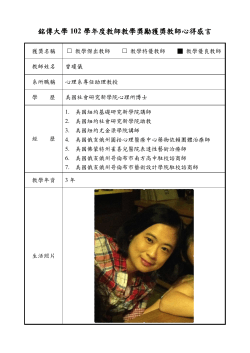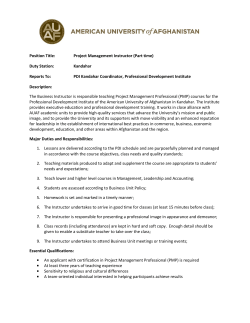
å¹³æ 27 年度 Global Standard Program ã·ã©ãã¹
平成 27 年度 Global Standard Program シラバス 科目名 Japan Studies 担当者名 Shane DOYLE 授業の概要 (ねらい・テーマなど) /Course Description (Course Objective・ Theme) 教科書 /Textbooks 参考書 (図書館蔵書には○) /References(Available in the library:○) Students will learn about different aspects of Japanese contemporary society. 必須入力 Materials provided by instructor 必須入力 In consultation with instructor 必須入力 授業計画・内容 /Class schedules and Contents 必須入力 Week 1: Introduction Week 2: 'Washoku' Week 3:Festivals Week 4:Sport & Leisure Week 5:Crime Week 6:Crime Week 7:Politics Week 8:Mid-term Week 9:Gender Week 10:Anime/Manga Week 11:Education Week 12:Ethnicity Week 13:Disability Week 14:Final Test Week 15:Review Class work/homework 40%, Mid-term 30%,Final 30% 成績評価の方法 /Assessment Method 必須入力 履修上の注意 /Remarks 教育担当者からの メッセージ /Message from the Instructor キーワード /Keywords 科目名 教養特講Ⅱ(グローバルワーク) 担当者名 永田 公彦 授業の概要 (ねらい・テーマなど) /Course Description (Course Objective・ Theme) 必須入力 教科書 /Textbooks 参考書 (図書館蔵書には○) /References(Available in the library:○) 本授業の狙いは、皆さんが、協力企業(団体)から与えられる「世界と地 域のつながりを深めるための課題」への主体的な取組みを通じ、グロー バル人材になるための基礎的な能力と知識を得ることです。取組みにあ たっては、、複数のチーム(留学生も含め6人前後で編成)が競いながら、 課題解決に向けてネット調査やフィールド調査(訪問又は街頭インタ ビュー等)を行い、その結果を、協力企業(団体)の方々にプレゼンテー ションして評価をいただきます。 なし(適宜プリントを配布します) 必須入力 なし 必須入力 1回~全体オリエンテーション 2回~14回 協力企業(団体)1~2社による課題の提示と説明、グループ 活動、協力企業(団体)に対する中間及び最終報告とプレゼンテーション 15回~全体の振り返りと総括 授業計画・内容 /Class schedules and Contents 必須入力 日常の授業と課外活動における次の2つを評価します。 1.個人ワーク(積極的な質問や発言、個人レポート1回) 2.グループワーク(積極的な参加と活動、中間及び最終プレゼンテー ション) 成績評価の方法 /Assessment Method 必須入力 履修上の注意 /Remarks 教育担当者からの メッセージ /Message from the Instructor キーワード /Keywords 1.授業時間以外のグループ活動が発生します(会議、フィールドワーク、 SNS等による情報交換) 2.実践の場で、英語を使う機会があります(外国人に対するインタビュー 等) 取組む課題は、例えば、国際観光、国際協力、国際PR等になります。皆 さんは、こうした課題に関する知識を得るだけにとどまらず、次のスキル を習得します。1)プロジェクトマネジメント、2)調査分析、3)社会人に向 けたプレゼンテーション、4)ロジカルシンキング、5)異文化マネジメント グローバル化社会における地域の活性化、プロジェクトマネジメント、グ ローバル人材、産学共同PBL (Project Based Management) 科目名 教養演習AⅡ(Debate) 担当者名 Adam Stott, Duncan Wotley, Robert Murphy 授業の概要 (ねらい・テーマなど) /Course Description (Course Objective・ Theme) 教科書 /Textbooks 参考書 (図書館蔵書には○) /References(Available in the library:○) 授業計画・内容 /Class schedules and Contents 成績評価の方法 /Assessment Method This course aims to improve students’ ability to use English for debating and discussing individual and social issues. Working in small groups, students will prepare and present three debates over the term. The final debate will be presented with a PowerPoint presentation. Materials will be provided by the instructor. Please bring a Japanese-English dictionary to all classes. 1回Introductions from instructor and students 2回The language and format of debate 3回Theme 1 - Family Issues. Students choose topics and start preparing the debate 4回Research and prepare debates 5回Students practice their debates with the instructor 6回Debate presentation no. 1 - Family Issues 7回Theme 2 - University Life. Students choose topics and start preparing the debate 8回Research and prepare debates 9回Students practice their debates with the instructor 10回Debate presentation no. 2 - University Life 11回Theme 3 - Social Issues. Students choose topics and start preparing the debate 12回Research and prepare debates using PowerPoint 13回Students practice their debates with the instructor 14回Debate presentation no. 3 - Social Issues 15回Debate review and self-evaluation Debate performance 1 = 25% Debate performance 2 = 25% Debate performance 3 = 25% Final exam = 25% 履修上の注意 /Remarks 教育担当者からの メッセージ /Message from the Instructor キーワード /Keywords Let's work together to enjoy the debates. Global Standard Program, Global Education Program 科目名 International Economics I 担当者名 FANG WEI (魏芳) 授業の概要 (ねらい・テーマなど) /Course Description (Course Objective・ Theme) 教科書 /Textbooks 参考書 (図書館蔵書には○) /References(Available in the library:○) 必須入力 The purpose of this lecture is to help students understand the basics of international trade and finance and the effects of various international economic policies in the world economy. This lecture focuses on the topics in international trade. Thomas A. Pugel, 2012, International Economics (15th Edition), McGrawHill International Edition. 必須入力 Paul R. Krugman, Maurice Obstfeld and Marc J. Melitz, 2015, International Economics: Theory and Policy (10th Edition). Pearson. 必須入力 Lecture 1: Introduction Lectures 2-3: Basic Theory: Demand and Supply Lectures 4-5: Comparative Advantage Lectures 6-7: Heckscher-Ohlin Theory Lectures 8-9: Gains and Losses from trade Lectures 10-11: Trade Policy: Tariff Lectures 12-13: Trade Policy: Nontariff Barriers Lectures 14-15: Trade Blocs 授業計画・内容 /Class schedules and Contents 必須入力 Final Exam 80% Assignments 20% 成績評価の方法 /Assessment Method 必須入力 履修上の注意 /Remarks 教育担当者からの メッセージ /Message from the Instructor キーワード /Keywords Students are suggested to take the lectures on microeconomic theory. 科目名 International Economics II 担当者名 FANG WEI (魏芳) 授業の概要 (ねらい・テーマなど) /Course Description (Course Objective・ Theme) 教科書 /Textbooks 参考書 (図書館蔵書には○) /References(Available in the library:○) 必須入力 The purpose of this lecture is to help students understand the basics of international trade and finance and the effects of various international economic policies in the world economy. This lecture focuses on the topics in international finance. Thomas A. Pugel, 2012, International Economics (15th Edition), McGrawHill International Edition. 必須入力 Paul R. Krugman, Maurice Obstfeld and Marc J. Melitz, 2015, International Economics: Theory and Policy (10th Edition). Pearson. 必須入力 Lecture 1: Introduction Lectures 2-3: balance of payments Lectures 4-5: Foreign Exchange Market Lectures 6-7: Interest Parity Lectures 8-9: Purchasing Power Parity Lectures 10-12: Government Intervention Lectures 13-15: International Lending and Financial Crises 授業計画・内容 /Class schedules and Contents 必須入力 Final Exam 80% Assignments 20% 成績評価の方法 /Assessment Method 必須入力 履修上の注意 /Remarks 教育担当者からの メッセージ /Message from the Instructor キーワード /Keywords Students are suggested to take the lectures on macroeconomic theory. 科目名 Introduction to Cross-cultural Communication 担当者名 Yamasaki, Kazuo 授業の概要 (ねらい・テーマなど) /Course Description (Course Objective・ Theme) 教科書 /Textbooks 参考書 (図書館蔵書には○) /References(Available in the library:○) 必須入力 This course will mainly focus on the communication gaps between native speakers of English and those of Japanese, and the aim of this course is to grope for the causes of these communication gaps, and to analyze them into social and cultural factors. No textbok. Handouts/Materials to be arranged by the instructor. 必須入力 References will be specified for the first class by the instructor 必須入力 1回 Introduction to this course 2回 What is Culture? What is Communication? 3回 Some aspects of Intercultural Communication 4回 Core of the culture:Value systems (Hofstede, cultural dimensions) 5回 Communication gaps and structurl gaps of English and Japanese 6回 Brief survey on cultural differences and critical incidents 7回 High and Low Context Culture and the critical incidents 8回 Brief survey on research methods: interviews, stastical process 9回 Non-verbal communication: Proxemics( Comfortable distance ) 10回 Non-verbal communication; Kinesics (Gestures, Eye contact etc.) 11回 Cultural difference observed in TV Commercials and other media 12回 Adaption to the different cultures 13回 Presentations by the students (Exchange students) 14回 Presentations by the students (Japanese students) 15回 Summary of the course 授業計画・内容 /Class schedules and Contents 必須入力 Class activity 40% Assignment&Quize 40% Final 20% 成績評価の方法 /Assessment Method 必須入力 履修上の注意 /Remarks 教育担当者からの メッセージ /Message from the Instructor キーワード /Keywords Students are required to give their opinions about themes presented in each of the classes, and to exchange their ideas to each other. In the final two classes students are expected to give a presentation (ten miutes, approximately) in Englsih on their own theme. The class is supposed to have exchange students. 科目名 Contemporary International Relations Law (現代国際関係法論) 担当者名 Mitsuru Kawamoto This course is aimed to faciliate to understand international relations law by introducing the basic theories of international law and its responses toward the global environmental issues in English. For the first half of the course, it is designed to introduce the foundational concepts of international law, the differences between international law and domestic law, as well as the legal nature thereof. Additionally, it will also introduce its historical developments. And for your understanding about international law more objectively and precisely, it is also essential to understand it from the perspectives of international politics. Therefore, the discussions from the perspectives of international law and international relations will be also introduced. Subsequently, "states in international law", "international organizations in international law", "no-state actors in international law" are also to be introduced. In the latter half of the course, for the "international relations law", the global environmental issues and the responses by international law toward them are to be taken up. This is so called "International Environmental (Sustainable Development) Law". In the lecture, it is aimed to understand how international law responded to the global environmental changes, and contributed to the solutions of the problems and the world order. The global issues that are to be taken up for case study are: ozone depletion, climate change, biodiversity loss, human rights and the environment, as well as trade and the environment, amongst others. Students who will take this subject are to be expected to participate in the discussions actively during the lectures. 授業の概要 (ねらい・テーマなど) /Course Description (Course Objective・Theme) 必須入力 The readings selected specially for the students taking this subject of Contemporary International Relations Law. The details will be explained on the first day of the lecture. 教科書 /Textbooks 必須入力 ①Shirley Scott, International Law in World Politics: Second Edition, Lynne Rienner Publishers, 2010. ②James Crawford and Martti Koskenniemi (eds.), The Cambridge Companion to International Law, Cambridge University Press, 2012. ③Robert J. Beck, Anthony Clark Arend, Robert D. Vander Lugt, International Rules: Approaches from International Law and International Relations, Oxford University Press, 1996. ④J. Craig Barker, International Law and International Relations, Continuum, 2000.( Available) ⑤Margaret P. Karns & Karen A. Mingst, International Organizations: The Politics and Processes of Global Governance, Lynne Rienner Publishers, 2004. ⑥Patricia Birnie, Alan Boyle, Catherine Redgewell, International Law and the Environment, Oxford University Press, 2009.(△Japanese Translation Edition is Available) ⑦Daniel Bodansky, Jutta Brunnee, Ellen Hey (eds.), The Oxford Handbook of Internatioanl Environmental Law, Oxford University Press, 2006. ⑧Marie-Claire Cordonier Segger and Ashfaq Khalfan, Sustainable Development Law: Principles, Practices, & Prospects, Oxford University Press, 2004. ⑨Tim Stephens, International Courts and Environmental Protection, Cambridge University Press, 2009. ⑩Rosemary Rayfuse & Shirley Scott, International Law in the Era of Climate Change, Edward Elgar Publishing, 2012. 参考書 (図書館蔵書には○) /References(Available in the library:○) 必須入力 Lecture 1: Orientation & Introduction (The Concept of International Law and its historical developments, The differences between International Law and Domestic Law) Lecture 2: The Concept of International Law and Its Historical Developments (How has international law developed?) Lecture 3: International Law and International Relations (Naturalism, Legal Positivism, Realism, Liberalism amongst Others.) Lecture 4: States in International Law (Sovereignty, Conditions for States, State Responsibility) Lecture 5: Intergovernmental Organizations in International Law (What is Intergovernmental Organizations? United Nations?) Lecture 6: Non-state Actors in International Law (Non-governmental Actors, Individuals) Lecture 7: Contemporary Issues that International Law faces (Reviews and Discussions TEST 1 (Mid-term Examination) * Essay Writing Style Lecture 8: Global Environmental Change and Internatioanl Law 1: Can International Law Protect the Global Environment? (Formation of global environmental law and policies and the developments of global environmental governance) Lecture 9: Global Environmental Change and Internatioanl Law2: The Structure of International Environmental Law (Regulation, Compliance, Implementation, Dispute Settlement) Lecture 10: Global Environmental Change and Internatioanl Law 3: Ozone Depletion and International Law (Ozone Treaty Regime) Lecture 11: Global Environmental Change and Internatioanl Law 4: Climate Change and International Law (Climate Change Treaty Regime) Lecture 12: Global Environmental Change and Internatioanl Law 5: Biodiversity and International Law (Biodiversity Treaty Regime, Ramsar Convention, World Heritage Treaty amongst Others) Lecture 13: Global Environmental Change and Internatioanl Law 6: Human Rights and the Environment (International Efforts to Protect Human Rights, Implications for the Environmental Issues) Lecture 14: Global Environmental Change and Internatioanl Law 7: Trade and the Environment (Breton Woods Regime, GATT Regime, WTO Regime, Trade and the Environment) Lecture 15: Global Environmental Change and Internatioanl Law 8: Future of International Law (Reviews and Discussions) 授業計画・内容 /Class schedules and Contents TEST 2 (Final Examination) * Essay Writing Style 必須入力 成績評価の方法 /Assessment Method 履修上の注意 /Remarks 教育担当者からの メッセージ /Message from the Instructor キーワード /Keywords Attendance & Participation (10%), Group Presentation (10%) and Essay (80%) 必須入力 1) It is critically important for you to attend the first lecture at the beginning of the course, since the whole subject design is to be fully explained. If not participate, you may miss the good opportunity to make most of your study in this subject. 2) It is encouraged to conduct desktop research by yourself through newspapers and internet amongst others, as well as to exchange your information and views on them with your colleagues. 3) In order to have fruitful lectures for you, it is planned to hear your interests, views and opinions as much as possible, at the beginning of and during the course. The subject will provide the good opportunity to deepen your basic understandings on international law, with a particular attention to global environmental issues, in English. The prior knowledge on international law and global environmental issues is not necessary. The lectures will be on the basic theory of international law introducing states, international organizations, international relations nexus, peaceful settlements of international disputes, and the responses of international law toward the issues of the global enviornment, such as ozone depletion, climate change, biodiversity, human rights and international trade. The subject is designed to give you the good opprtunities to express your ideas, views and opinions as well. Therefore, you will be expected to participate in the discussions and group presentations actively and positively in English. Also, the opportunities to write research essays in English are designed. International Relations Law, International Law, International Environmental Law, International Sustainable Development Governance, International Organizations, Politics of International Law. 科目名 Critical readings for foreign literature B (Environmental Issues and Policy Making) 担当者名 SHIN,Dong-Ae (申東愛) This course provides an overview of environmental issues and policy. In this course we will examine the policy process, behavior of actors like political parties, politician, interest groups etc. And we will also talk about the environmental issues such as waste, land use, climate change and development. Course objective *Understanding the environmental issues *Understanding the environmental policy and policy process. *Develop skill in critical thinking and talking about the issues. 授業の概要 (ねらい・テーマなど) /Course Description (Course Objective・ Theme) 必須入力 教科書 /Textbooks 参考書 (図書館蔵書には○) /References(Available in the library:○) There is no textbook, Printed material will be provided. 必須入力 Michael E. Kraft, Environmental Policy and Politics (Longman Press, 6th ed., 2014) Lester R. Brown, Plan 4.0 (W.W Norton & Company, 2009) 必須入力 Lecture1: Introduction Lecture2-4: Policy problems, Policy and policy process. Lecture5-12: Environmental Issues and policies Lecture13-14: Presentation Lecture15: Summary 授業計画・内容 /Class schedules and Contents 必須入力 Preparation and Participation: 40% Assignments: 30% Final test:30% 成績評価の方法 /Assessment Method 必須入力 履修上の注意 /Remarks 教育担当者からの メッセージ /Message from the Instructor キーワード /Keywords *All students are required to attend every class, if a student must miss a class, inform the teacher before the class. *All students are strongly required to take the course on "Environmental Policy", "Policy Process" provided by the faculty of law. *All students need to participate in the group discussion during the class. 科目名 実践英語600 担当者名 木原 寛子 授業の概要 (ねらい・テーマなど) /Course Description (Course Objective・ Theme) 教科書 /Textbooks 参考書 (図書館蔵書には○) /References(Available in the library:○) 授業計画・内容 /Class schedules and Contents (1)TOEICのスコアアップとともに、ビジネス英語の基本を学習する (2)知識 レベルの語彙、語法を実用レベルに高める。(3)クラスでのアクティビティを通 して実践力を伸ばす (4) 時事英語への導入 必須入力 (前期) TOEICテスト 新 最強トリプル模試2(改訂新版)The Japan Times (後期) TOEICテスト 新 最強トリプル模試3(改訂新版)The Japan Times 必須入力 授業内で適宜紹介する 必須入力 1回 オリエンテーション TOEICへの導入 2回 Part I (1) / Part V (1) / Part VII(1) 3回 Part I (2)/ Part V(2) / Part VII (2) 4回 Part I (3) / Part V (3) / Part VII (3) 5回 Part II (1) / part V (4) / Part VII (4) 6回 Part II (2) Part V (5) / Part VII (5) 7回 Part II (3) / Part V (6) / Part VII (6) 8回 Part III (1) / Part V (7) / Part VII (7) 9回 Part III (2) / Part V (8)/ Part VII (8) 10回 Part III (3) / Part V (9) / Part VII (9) 11回 Part IV (1) / Part VI (1) / Part VII (10) 12回 Part IV (2) / Part VI (2) / Part VII (11) 13回 Part IV (3) / part VI (3) / Part VII (12) 14回 Part IV (4) / Part VI (4) / Part VII (13) 必須入力 15回 まとめ ビ 成績評価の方法 /Assessment Method 必須入力 履修上の注意 /Remarks 教育担当者からの メッセージ /Message from the Instructor キーワード /Keywords 前期と後期で使用テキストが違うので購入の際は注意して下さい。 毎回、スキットの暗唱、Reading、演習など課題が出され、授業外でも自己学習 が必要なクラスです。 科目名 Global Education Program(木・6限) 担当者名 足立科子 授業の概要 (ねらい・テーマなど) /Course Description (Course Objective・ Theme) 教科書 /Textbooks 参考書 (図書館蔵書には○) /References(Available in the library:○) 受講生の現在のレベルよりもやや高いレベルの内容を扱いながら、英語 力の底上げを図る。 必須入力 Interactive Business English on DVD / DVDで学ぶ実践的ビジネス英語(SEIBI 必須入力 なし 必須入力 TOEIC対策は基本的に校内テストスケジュールに合わせてクラスでも問 題演習などを行うが、基本的にはTOEICよりも負荷のかかるリスニングや リーディングに取り組むことで実力を伸ばす。クラスが少人数ならば、リス ニングやリーディングでインプットした内容を英語で再現したうえで自分の 意見を述べたり、ニュースを作成するなどのアクティビティも取り入れる予 定。 授業計画・内容 /Class schedules and Contents 必須入力 なし 成績評価の方法 /Assessment Method 必須入力 履修上の注意 /Remarks 教育担当者からの メッセージ /Message from the Instructor キーワード /Keywords 科目名 実践英語 800 担当者名 松田由美子 授業の概要 (ねらい・テーマなど) /Course Description (Course Objective・ Theme) 教科書 /Textbooks 参考書 (図書館蔵書には○) /References(Available in the library:○) 必須入力 TOEIC800点を目指すトレーニングに加え、英語実践力を養成します。 学生の傾向として、リスニング力は高いがアカデミックなスピーキング力 が低い。ディスカッション、スピーチ、ディベート等の実践を通してその ギャップを解消していきます。時事英単語の継続的学習。 ・Tactics for TOEIC Listening and Reading Test (OXFORD) 通年使 用 ・毎回配布:時事英単語プリント 必須入力 必須入力 1回 Orientation, self introduction speech 2回以降 以下の予定 1:IELTS Q&A 2:時事英単語 3:テキストにてTOEIC対策 (シャドウイング、リプロダクション等導入) 4:スピーキングセッション(ディベート、スピーチ、ディスカッション、通訳) 授業計画・内容 /Class schedules and Contents 必須入力 成績評価の方法 /Assessment Method 必須入力 履修上の注意 /Remarks 教育担当者からの メッセージ /Message from the Instructor キーワード /Keywords TOEICスコアアップに特化したクラスではなく、パフォーマンスを通した実 践力養成トレーニングにも重点を置いていることを理解した上で履修する こと。 英語通訳者としての経験を生かしたトレーニングを提供し、学生のセルフ トレーニング継続につなげることもねらいのひとつです。そして積極的な 授業参加なしにはスピーキングスキルは向上しません。 科目名 Global Standard Program 実践英語(木曜4限目) 担当者名 岸川ゆかり 授業の概要 (ねらい・テーマなど) /Course Description (Course Objective・ Theme) 教科書 /Textbooks 参考書 (図書館蔵書には○) /References(Available in the library:○) ビジネスの様々な場面において、頻繁に用いられる英語表現及び語彙を 4方向から学ぶ。ビジネスの現場のルールやマナーを身につける。 必須入力 Business as Usual 「成美堂」 必須入力 英字新聞経済面 必須入力 1回 Introduction Lesson 1 語彙強化 速読 2回 小テスト Lesson 1 語彙強化 速読 3回 小テスト Lesson 2 語彙強化 速読 4回 小テスト Lesson 2 語彙強化 速読 5回 小テスト Lesson 3 語彙強化 速読 6回 小テスト Lesson 3 語彙強化 速読 7回 小テスト Lesson 4 語彙強化 速読 8回 小テスト Lesson 4 語彙強化 速読 9回 小テスト Lesson 5 語彙強化 速読 10回 小テスト Lesson 5 語彙強化 速読 11回 小テスト Lesson 6 語彙強化 速読 12回 小テスト Lesson 6 語彙強化 速読 13回 小テスト Lesson 7 語彙強化 速読 14回 小テスト Lesson 7 語彙強化 速読 15回 小テスト Lesson 8 語彙強化 速読 授業計画・内容 /Class schedules and Contents TOEIC Part 7 TOEIC Part 7 TOEIC Part 7 TOEIC Part 7 TOEIC Part 7 TOEIC Part 7 TOEIC Part 7 TOEIC Part 7 TOEIC Part 7 TOEIC Part 7 TOEIC Part 7 TOEIC Part 7 TOEIC Part 7 TOEIC Part 7 TOEIC Part 7 必須入力 単位評価は行いません。 成績評価の方法 /Assessment Method 必須入力 履修上の注意 /Remarks 教育担当者からの メッセージ /Message from the Instructor キーワード /Keywords 上記テキスト以外にもその時々で副教材を用います。 受講する学生には予習復習をしっかり行うことを求めます。授業にはテキスト、辞書、語彙 ノート(各自が受講中に作成していくノート)とルーズリーフ式ノート(課題提出用)を必 携すること。課題は期限内に提出すること。様々な英文に慣れるために日ごろからインター ネットのニュースや英字新聞に目を通す習慣をつけましょう。 科目名 Global Standard Program 実践英語 (土曜4限目) 担当者名 岸川 ゆかり 授業の概要 (ねらい・テーマなど) /Course Description (Course Objective・ Theme) ビジネスの様々な場面において、頻繁に用いられる英語表現及び語彙を 4方向から学ぶ。 ビジネスの現場のルールやマナーを身につける。 必須入力 Interactive Business English on DVD 「成美堂」 教科書 /Textbooks 必須入力 参考書 (図書館蔵書には○) /References(Available in the library:○) 授業計画・内容 /Class schedules and Contents 英字新聞経済面 必須入力 1回 Introduction 2回 小テスト 3回 小テスト 4回 小テスト 5回 小テスト 6回 小テスト 7回 小テスト 8回 小テスト 9回 小テスト 10回 小テスト 11回 小テスト 12回 小テスト 13回 小テスト 14回 小テスト 必須入力 15回 小テスト 成績評価の方法 /Assessment Method Chapter 1 Chapter 1 Chapter 2 Chapter 2 Chapter 3 Chapter 3 Chapter 4 Chapter 4 Chapter 5 Chapter 5 Chapter 6 Chapter 6 Chapter 7 Chapter 7 Chapter 8 語彙強化 速読 TOEIC Part 7 語彙強化 速読 TOEIC Part 7 語彙強化 速読 TOEIC Part 7 語彙強化 速読 TOEIC Part 7 語彙強化 速読 TOEIC Part 7 語彙強化 速読 TOEIC Part 7 語彙強化 速読 TOEIC Part 7 語彙強化 速読 TOEIC Part 7 語彙強化 速読 TOEIC Part 7 語彙強化 速読 TOEIC Part 7 語彙強化 速読 TOEIC Part 7 語彙強化 速読 TOEIC Part 7 語彙強化 速読 TOEIC Part 7 語彙強化 速読 TOEIC Part 7 語彙強化 速読 TOEIC Part 7 単位認定は行いません。 必須入力 履修上の注意 /Remarks 教育担当者からの メッセージ /Message from the Instructor キーワード /Keywords 上記テキスト以外にもその時々で副教材を用います。 受講する学生には予習復習をしっかり行うことを求めます。授業にはテキ スト、辞書、語彙ノート(各自が受講中に作成していくノート)とルーズリー フ式ノート(課題提出用)を必携すること。 課題は期限内に提出するこ と。様々な英文に慣れるために日ごろからインターネットのニュースや英 字新聞に目を通す習慣をつけましょう。
© Copyright 2025









